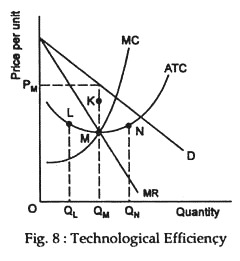The following points highlight the three main consequences of monopoly. The consequences are: 1. Technological Efficiency 2. Monopoly and Innovation 3. Allocative Inefficiency.
Consequence # 1. Technological Efficiency:
Whether a monopoly will be technologically efficient cannot be determined by theory alone. It is possible that MR=MC=minimum ATC, as shown in Figure 8. however, this need not be the case. If MC=MR at some other level of output, such as QN or QL the firm is operating at higher than minimum cost, even though it is on its ATC curve. The firm may not even be on this curve. It could produce at QM and be incurring costs of K—a situation that can occur.
Fig.8, makes it quite clear that the cost and revenue curves for this firm are such that it operates at minimum average cost and is technologically efficient, however, were QN or QL the profit maximizing output, the firm would still continue to operate even though costs are above minimum. In fact, the firm may produce QM and yet have costs of K which is not even on the ATC curve.
ADVERTISEMENTS:
With economic profits and no competitors, a monopoly may relax somewhat in its efforts to keep costs down; it does not feel the constant pressure to minimize costs that a firm in a more competitive environment does. Or it may choose to spend money in order to be “socially responsible”.
Consequence # 2. Monopoly and Innovation:
One extra cost is for research and development (R & D). In the absence of competition, firms need not employ available technology to the fullest extent. Since monopolistic firms are not immediately threatened by competition, they may feel little pressure to develop new methods to reduce their costs of production.
Moreover/when new methods do come to light; monopolistic firms sometimes suppress them if these methods undermine their secure hold on the market. On the other hand, R & D is a way of keeping one step ahead of possible competitors, and some firms have used it with great effectiveness. And because there is less pressure to operate at the lowest cost, a monopoly may be more willing than a firm in a competitive industry to maintain advanced research facilities.
Consequence # 3. Allocative Inefficiency:
The profit maximising monopolist always sells at a price greater than marginal cost, which automatically results in allocative inefficiency. A simple example will illustrate how a monopoly causes inefficient resource allocation. Say we live in an economy with two industries—leather doublets and belts. The belt industry is a monopoly, and the doublet industry is purely competitive.
ADVERTISEMENTS:
Both industries are in equilibrium, and both are operating at a level of output at which marginal cost equals Rs.5. In the belt industry, price is greater than marginal cost: it is Rs.8. In this situation resources are not allocated efficiently between belts and doublets. There are too many resources devoted to doublet production and too few to belt production.
By shifting Rs.5 worth of resources from doublet to belt production, society could produce an additional belt. Consumers would lose one doublet that they value at Rs.5, but they would better off because they would gain a belt that they value at Rs.8. To achieve a more efficient allocation of resources, doublet production should be decreased and belt production increased.
As a general rule, if price is greater than marginal cost (and there are no externalities), marginal social value is greater than marginal social cost, and production of that good should be increased. As this happens, the price will fall and marginal cost will rise until P=MC, or efficient resource allocation is achieved. If the price is less than the marginal cost, the reverse should occur.
In our example, were the belt industry suddenly to become competitive, belt production would increase because price is greater than marginal cost. The price of belts would fall as resources shifted from doulets, until the price of a belt equalled its marginal cost. Allocative efficiency would follow.
